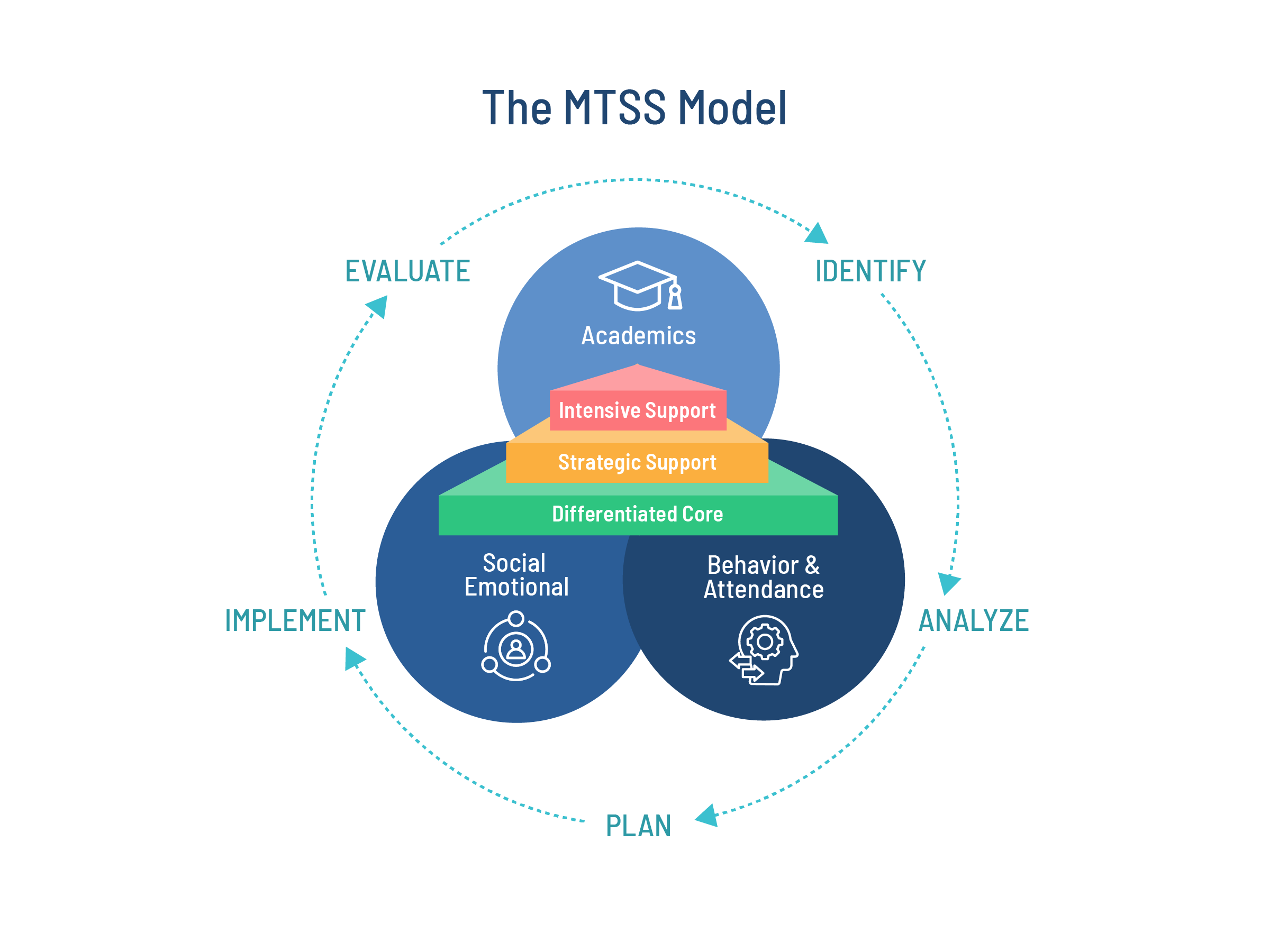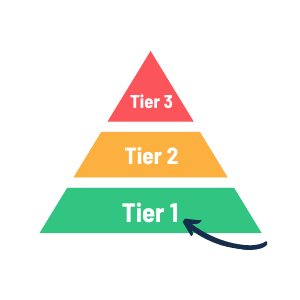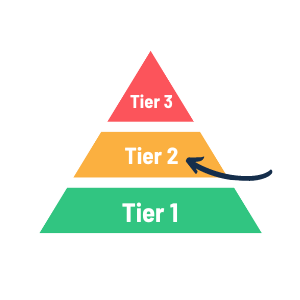As more and more schools implement a Multi-Tiered System of Supports, a common question I hear in my work as an educational consultant among teachers, administrators, and instructional leaders is, “How are Tier 1 and Tier 2 Different"? They want to know what it means to differentiate at the Tier 1 level and how this differs from a Tier 2 intervention. It is a valid question that resonates with frustrated teachers experiencing initiative fatigue. The bottom line is that teachers want to understand how their daily instruction is expected to change.
For many teachers, MTSS sounds like something new, when in reality, implementing MTSS will help align all the initiatives and strategies already operating in their schools. So let's clarify the overlap and distinction between these layers of instruction to help schools know how to organize support for their students best.
The Difference Between Tier 1 & Tier 2 Key Takeaways
- Tier 1 is for all, but it’s not one-size-fits-all. Core instruction should be differentiated daily to meet the diverse needs of learners—this is the foundation of effective MTSS.
- Tier 2 targets specific skill gaps—not general support. When Tier 1 isn’t enough, Tier 2 delivers focused, data-driven interventions in small groups without replacing universal instruction.
- Clarifying the tiers reduces initiative fatigue. Understanding how Tier 1 and Tier 2 align helps teachers streamline their work, improve efficiency, and support students more effectively.
An Overview of MTSS
A Multi-Tiered System of Supports (MTSS) is a whole-school, prevention-based framework that relies on data-based problem-solving to support all students within a layered continuum of evidence-based practices and systems. MTSS, as a foundation, provides academic, behavioral, and social-emotional interventions organized into three tiers of support.

The three tiers are also referred to as levels or layers of support that educators provide to students. Within each level, various resources, strategies, and tools support students’ various needs. And the good news is, MTSS works! When implemented with fidelity, I have seen teachers marvel at how a suggested support or instructional strategy solved a problem they faced in addressing a student’s need.
A solid MTSS implementation requires that the essentials for each tier of instruction are in place and functioning properly. The key to an effective and efficient intervention program is solid Tier 1 core instruction, with differentiation embedded into daily lesson structure. As schools hone in on Tier 1 instruction and strive to create rich learning experiences that meet the needs of all students, they can effectively determine which students need additional Tier 2 targeted support.
Let’s take a closer look at these first two tier levels to delineate how they differ.
Tier 1 - Core Instruction

Within MTSS, emphasis is placed on Tier 1 or core instruction that is universal (for all students). Tier 1 provides the foundation for targeted instruction and interventions, ans the day-to-day instruction that all students receive. As such, teachers should intentionally plan to differentiate based on the multiple learning needs of students in their class. No single strategy or combination of strategies will be effective for every student in every class and school. Therefore, teachers must approach instruction using various tools to
differentiate lesson activities, so all students can access curriculum materials.
Instructional strategies change as lesson activities change and as students change. Along with rich curricular materials that provide rigorous, reflective, and relevant activities, teachers should have a robust collection of tools that help students access core materials and encourage them to think critically. The goal is for universal instruction to be as effective as possible for all students. However, there is one question I often hear from teachers when I highlight robust, high-quality universal instruction for their students, “How do you do all this?”
A wide body of research has demonstrated that these critical practices can impact student achievement across different content areas (Ball & Forzani, 2011, p. 19). Teachers must desire to reach all students and have an internal belief that every student can achieve. Teachers must also have a standards-based curriculum implemented consistently, and that offers differentiated tasks and ways for students to access the content and demonstrate mastery of it.
💡Blog: How Teachers Can Support Student Intervention Plans in Core Instruction
The Importance of Student Engagement in Tier 1
A critical part of this effective instruction is making the learning process engaging for students based on areas of strength, need, and learning preferences. Approaching instruction in this way ensures students make connections to content and find relevance in the lessons being taught. For example, a teacher can provide printed text and an audiobook of a story when teaching reading comprehension skills.
Teachers can scaffold lessons by discussing with the class how to arrive at an answer, instead of using rote questions that elicit one-word answers. Teachers can build student discourse by encouraging students to debate, instead of calling on student after student until someone provides the desired answer.
Students need the opportunity to be set up for success and win—to work through something cognitively challenging and arrive with a correct answer and deeper understanding. Asking students to prove or justify their answers lessens students’ tendency to speedily provide a solution without giving others time to think it through deeply. If only correct answers are highlighted and celebrated, students lose interest and will not engage because they aren’t confident they have the “right” answer.
💡Blog: How To Use the EPIcenter of MTSS to Drive Progress for Your Students
Collaboration at the Core of MTSS
Regular collaboration with peers and drawing from one another’s expertise supports a deep understanding of MTSS processes. There may be classroom strategies that a colleague uses to bridge a learning gap. This type of collective strategizing is a powerful tool to strengthen Tier 1 core instruction and empower student learning, because they are supported and provided multiple opportunities to engage and experience success.
Just as collaborative learning develops higher-level thinking in students, collaboration is at the core of an MTSS. It helps teachers look at student data and make decisions about how to best support their varied needs. The exchange of ideas can make teacher practice more efficient. There is research to support the positive effect of teacher collaboration on student achievement (Vincent-Lancrin et al., 2017).
Using Collaboration to Meet the Needs of ALL Students in Tier 1
The goal of Tier 1 core instruction is to meet the learning needs of all students. Taking time to dissect what is happening instructionally at Tier 1 ensures students have equitable access to high-leverage practices and instruction. (Vincent-Lancrin et al., 2017)
Teachers can learn how to address the needs of students who may otherwise be labeled slow learners or need special services. When there is a student misconception or when students are struggling, formative assessments and check-ins allow teachers to address students’ needs and fine-tune their instruction.
A misconception or need for reinforcement is not always indicative of a student's need for Tier 2 or Tier 3 support. Much like benchmark data, which helps understand students’ growth and ability level, formative assessments help tailor instruction so that deficits and misconceptions are addressed throughout the instructional cycle. Having the right data can help a teacher make the right instructional choices.
Focus on Tier 1 instruction is even more important now, as teachers face significant numbers of students in need of support. And with current teacher shortages, it’s likely that schools will need to be creative and collaborative in meeting the needs of students who have fallen behind.
💡 Blog: How MTSS Has Increased Collaboration for This Teacher
Tier 2 - Targeted Supplemental Intervention

Tier 2 intervention is targeted to support a specific skill gap. It is typically delivered as small group intervention to students with a common need in academics or SEBL (Social Emotional Behavior Learning). Tier 2 instructional support builds on the foundational core instruction of Tier 1.
By determining and grouping students who need specialized support, teachers can efficiently address the specific area of deficit, as well as determine which students may need more intensive, individualized Tier 3 support. Tier 2 instruction provides research-based interventions to address specific areas, without compromising the additional support that all students receive at Tier 1 with differentiated instruction.
Tier 2 Interventions Can Include:
-
Academic interventions that provide students with explicit instruction on missing academic skills with multiple examples.
-
Behavioral interventions that provide structure, encouragement, and feedback, such as Check In-Check Out.
-
Structured mentorship (often from outside the school) to provide a positive role model and promote engagement in academic and leadership activities.
-
Programs in which students participate in campus or community jobs that build relationships and may also tie in with academic learning.
-
Setting-based interventions that provide structure to modify undesirable behaviors and eliminate distractions that may impede engagement in the instruction of lesson content.
Tier 2 interventions are delivered in short spurts of time and monitored to track student progress. By developing a specific student support plan to address identified needs, teachers can track the utility of an intervention based on student progress toward a goal. A plan for providing Tier 2 support should include a targeted focus, specific and measurable goals, a progress monitoring plan, and an end date to check for progress.
📕 Guide: The Tier 2 Behavior Intervention Guide
How Do Tier 1 and Tier 2 Support Each Other?
Tier 1 instruction is standards-driven, focusing on students' broad skills and generalizing to a learning target. In contrast, Tier 2 intervention targets a specific skill deficit identified through assessment. Instruction and intervention targets this specific skill. Educators develop a support plan to address the targeted skill with intervention tools that address the need, and monitor growth on that specific skill with a normed progress monitoring tool.
Ongoing progress monitoring of Tier 2 interventions helps teachers identify if students are improving and responding to the intervention. If students progress and achieve Tier 2 intervention plan goals, the learning gap has been addressed, and they can continue with Tier 1 core instruction without the additional targeted support.
A key difference between Tier 1 instruction and Tier 2 intervention is the focus on targeted skills.
When teachers define Tier 1 and Tier 2 processes, they bring cohesion to their efforts to support student learning. Students are supported at a deeper level during core instruction. Teachers gain a clearer understanding of students who actually need additional targeted instructional support. Data is used to inform instruction and intervention, and teachers strengthen their practice by being more efficient and effective.
Citations
Ball, D. L., & Forzani, F. M. (2011). Building a common core for learning to teach and connecting professional learning to practice. American Educator, 17-21, 38-39.
Vincent-Lancrin, S. G, Jacotin, J., Urgel, S., Kar, C., and González-Sancho (2017). Measuring Innovation in Education: A Journey to the Future. Paris: OECD Publishing.
IRIS Center, https://iris.peabody.vanderbilt.edu/module/rti03/cresource/q4/p11/
About the author
Branching Minds
Branching Minds is a highly respected K-12 services and technology company that leverages the learning sciences and technology to help districts effectively personalize learning through enhancements to their MTSS/RTI practice. Having worked with hundreds of districts across the country, we bring deep expertise in learning sciences, data management and analysis, software design, coaching, and collaboration. Combined with our extensive toolkit of resources, PD, and technology, we provide a system-level solution. We are more than a service or a software provider, we are partners who will deliver sustainable results for educators, and a path to success for every learner.

Empower Student Success
Support students at every level with Branching Minds—your partner in delivering targeted, effective interventions through a streamlined MTSS approach.













.png?width=1436&height=956&name=What%20Is%20the%20Difference%20Between%20Tier%201%20and%20Tier%202%20in%20MTSS%20(preview).png)



.png?width=716&height=522&name=Tier%203%20Behavior%20Support%20Planning%20(preview).png)